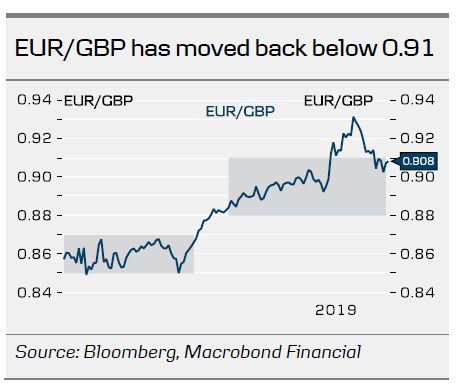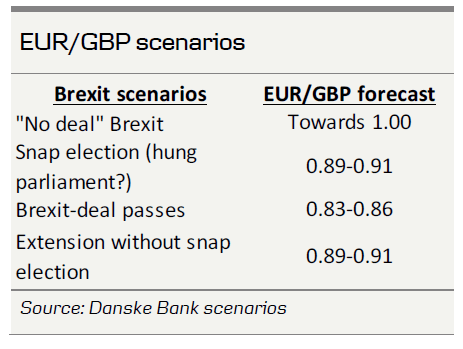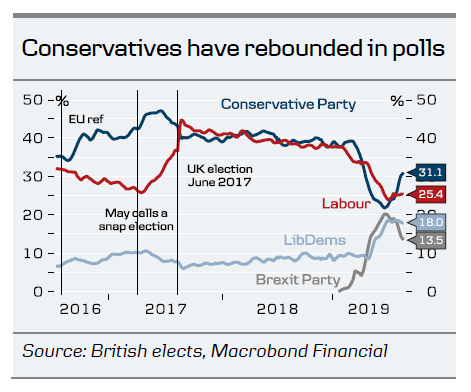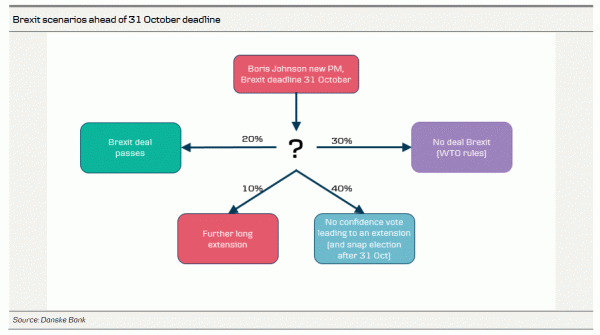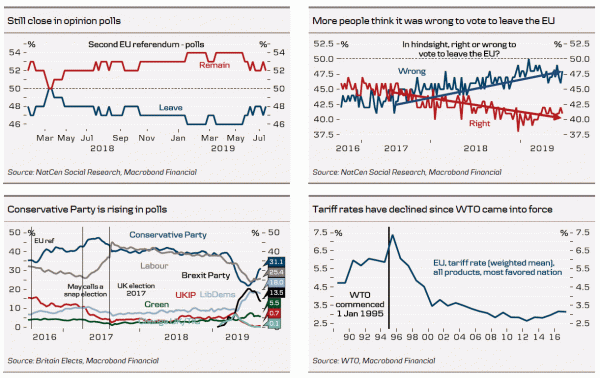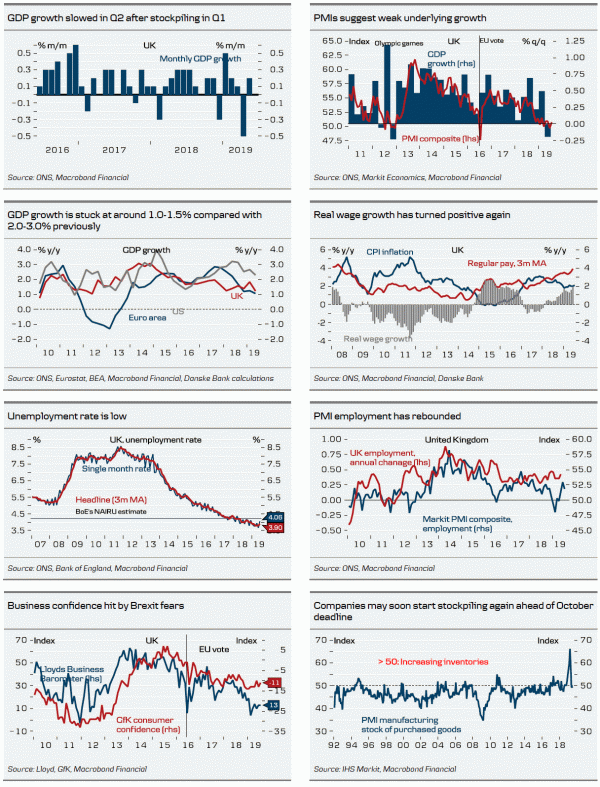Key takeaways
- On the back of the recent development, we change our view and now think the two most likely scenarios are (1) a no-confidence vote leading to an extension (and later a general election) (40% probability) and (2) a no-deal Brexit (30% probability).
- Political developments on Brexit do not warrant a change in our view that EUR/GBP will fluctuate around 0.90 on a 1-12M horizon. Crucially, we are not converging on any one extremely GBP-negative or GBP-positive scenario.
More complicated, not impossible, to block no-deal Brexit
It has been a month since we updated our Brexit view (see Brexit Monitor – There is always a but , 29 July) and a lot seems to have happened. Initially, both the Boris Johnson government and the EU sharpened their rhetoric but over the past couple of weeks, the tone seems to have softened on both sides .
This week, Prime Minister Boris Johnson announced his intention to prorogue Parliament from mid-September to 14 October. The current parliamentary session began in 2017 and a new Queen’s Speech, which marks the beginning of a new parliamentary session and in which the government lays out its political programme, is long overdue. While Boris Johnson argues that he needs a new Queen’s Speech to explain his political priorities, the decision should be seen in the light of Brexit. The consequence of the prorogation is that it limits the anti no-deal Brexit lawmakers’ possible ways to block a no-deal Brexit through legislation (which was their favourite approach), as Parliament does not sit (i.e. cannot pass laws). That said, it has become more difficult, not impossible, to block a no-deal Brexit.
In this document, we take a closer look at the different scenarios ahead of 31 October and update our game probability tree (see page 4).
Our new base case is that a small majority in the House of Commons will eventually bring the Johnson government down, form a temporary government, ask the EU 27 for an extension and call for election when the extension is granted (40%). We want to stress that uncertainty is high and this is not a high conviction call. The likelihood of a no-deal Brexit has also increased on the back of the prorogation, as it limits the possible ways for politicians to block it (30%). We also take notice of the positive development between the UK government and the EU and think the probability of a Brexit deal passing has increased to 20%. Our old base case with an outright extension without an election seems like the less likely scenario now (10%).
Case 1: No-confidence vote leading to an extension (and general election after 31 October) (40%)
Our new base case is that a small majority will eventually bring the government down, form a temporary government asking for a Brexit extension and make sure there will be a general election (40%). This scenario has become more likely since Prime Minister Johnson’s decision to prorogue Parliament, as this is now probably the easiest way for the anti no-deal politicians to block a no-deal Brexit. There is still a small majority in the House of Commons who will go a long way to avoid a no-deal Brexit.
This move may still be easier said than done. It is difficult for the moderate Conservative MPs to vote with the opposition against the Conservative-led Johnson government. In our view, a no-confidence vote is most likely after the EU summit on 17-18 October, as it would give Johnson a chance to negotiate with the EU. There are up to 40 moderate Conservative MPs (see, for example, The Express) who want to avoid a no-deal Brexit. While not all of them want to bring down the Conservative government, ex-Chancellor Philip Hammond has said he ‘will not exclude’ backing a no confidence vote in such a scenario (see BBC). Given the government has a working majority of only one, not many Conservatives need to put ‘country over party’ for the government to fall.
A major issue with this approach is deciding who should be ‘caretaker’ Prime Minister. Labour leader Jeremy Corbyn argues that he, as leader of the biggest opposition party, should be Prime Minister but that is a non-starter for the Conservative rebels. Cross-party rivalries risk jeopardising the anti no-deal Brexit politicians’ attempts to block a no-deal Brexit. This is also the reason a no-deal Brexit, which is still the default option from a legal perspective, may happen simply ‘by accident’.
What will happen after a possible election is difficult to say at this point and depends on the election results. Current polls suggest the Conservatives may get a strong result. However, there is also a risk of a hung parliament and that Johnson becomes the shortest serving Prime Minister on record.
Case 2: No-deal Brexit (30%)
We lifted our assumed probability of a no-deal Brexit from 20% to 30%, as we admit we seem to have underestimated the credibility of Johnson’s threat. In addition, the prorogation of Parliament has made it more complicated to stop a no-deal Brexit. With the Conservatives back above 30% in the opinion polls, as voters are returning from The Brexit Party, more moderate Conservative MPs may feel it is difficult to vote against the Conservative-led government in a no-confidence vote.Despite both the UK and the EU 27 seemingly softening their stances, it is still complicated to reach an agreement that satisfies everyone and that can pass in the House of Commons.
Case 3: Deal Brexit (20%)
From a political perspective, two months is a long time and, in this sense, there is still plenty of time to strike a deal. PM Johnson now seems more pragmatic on the backstop and is willing to talk. The EU 27 has changed its rhetoric from ‘the Withdrawal Agreement is not open for renegotiation’ to hinting it is up to the UK to find ways to avoid the backstop. One way seems to be a downscaled sector-to-sector backstop (e.g. with the same rules applying only to agricultural foods and animal welfare) and trusted trading schemes. However, Ireland is against this. On the back of this, we lift our assumed probability of a deal passing from 15% to 20%. While we view the renewed Brexit talks as positive, we are cautious, as this should be seen in the light of the ongoing blame game in the event that a no-deal Brexit happens (for whatever reason). However, the pressure on both sides is increasing as we get closer to the Brexit deadline. Do not be surprised if we have to get very close to the Brexit deadline before a deal is reached. Right now, it is still early days.
There are two reasons we are still not that optimistic about the prospect of a deal. First, while the incentive to strike a deal is definitely there, it is difficult to avoid a border where there should logically be one. It may not be juridically possible to find a compromise that satisfies both sides. Second, it is not a given that a change to the backstop is enough to make the hardcore Brexiteers happy. Some of the hardcore Brexiteers have already made it clear that they do not think a removal of the backstop is sufficient; for example, Paul Brand from ITV tweeted ‘EXCLUSIVE: Deputy Chair of the ERG tells me they will REJECT the PM’s Brexit deal if it simply involves the removal of the backstop. Seems like all routes lead to No Deal.’
With a working majority of only one, Prime Minister Boris Johnson cannot avoid losing too many Conservative votes. The strategy could be to persuade pro-Brexit Labour politicians to vote in favour of the deal but it is also difficult for them to vote with the Conservative government. Given two months may not be sufficient, we cannot rule out a short extension would be needed to implement all necessary legislation in this scenario.
Case 4: Further long extension (without snap election) (10%)
Admittedly, we have overestimated the probability of a Brexit extension without a snap election and with Johnson’s prorogation, the probability seems to have declined substantially. The prorogation makes it very difficult for the small majority in the House of Commons to try to force Prime Minister Johnson to ask the EU 27 for another extension by legislation, which was the anti no-deal Brexit politicians’ favoured strategy (easier to agree on than forming a temporary cross-party unity government as in Case 1).
It is still not impossible for the politicians to move forward when the House of Commons returns on Tuesday 3 September. The politicians could request an emergency debate (Standing Order 24 procedure). One problem here is that they are usually not binding votes but House Speaker John Bercow could decide to break with precedents and allow a vote taking control over the Commons order on a given day. This would give the politicians the opportunity, for example, to force Prime Minister Johnson to ask for an extension. The problem here is that the wording of the law must be very precise, as the EU negotiates only with governments and not parliaments and Prime Minister Johnson may simply choose to refuse the terms of extension. Another problem is that the Government may try to hijack the legislation process by ‘filibustering’ the approval in the House of Lords.
FX outlook
UK Prime Minister Johnson’s announcement moved EUR/GBP above 0.91 yesterday. While the move eased a little during the day, the market is clearly shifting some probability towards a new election and/or a no-deal scenario, halting the recent downtrend in EUR/GBP for now. In coming months, it will be crucial to look for signs of a possible no-confidence vote against Johnson. In this case, we could converge on a mildly GBP-positive scenario. Also, should the position between the EU and the UK soften and smell of a deal, it would clearly be GBP positive. On the whole, the latest political developments on Brexit do not warrant a change in our view of EUR/GBP fluctuating around 0.90 on a 1-12M horizon. A 50% probability mass still gathers around some form of extension beyond October (see game tree of scenarios overleaf), suggesting a large jump in GBP is not on the cards. That said, we strongly recommend respecting the risk surrounding possible outcomes, including a heightened risk of no deal, and keeping high hedge ratios on GBP exposure. Notably, we remain very negative on GBP in the case of a no-deal Brexit, where we still see EUR/GBP moving towards parity.
In the event of an orderly Brexit (one way or another), we expect EUR/GBP to move lower, probably down to the 0.83-0.86 range. Our case base is for this to happen late in 2020.




